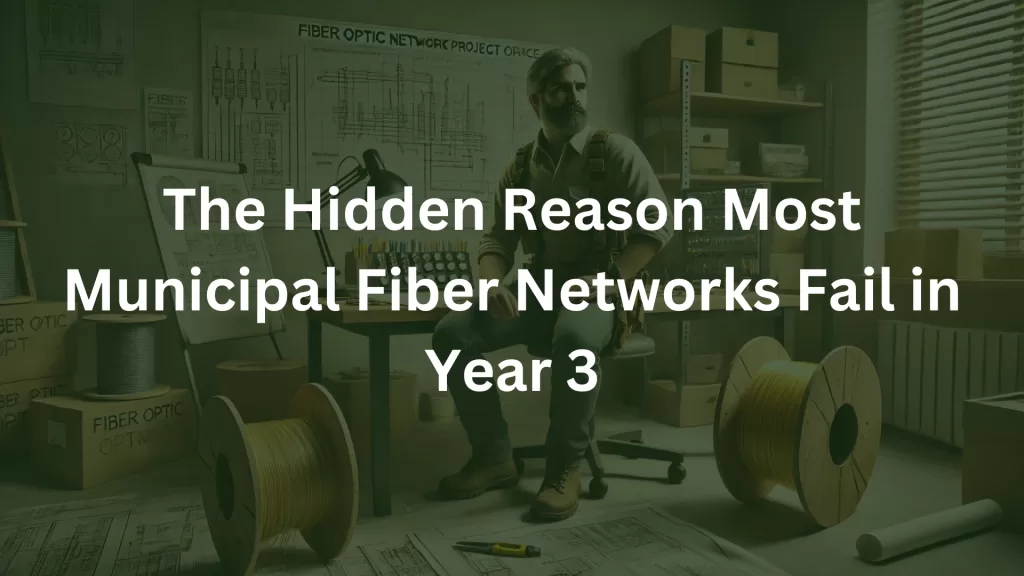
It starts with a meeting no one wants to have.
The city council room is quiet. Too quiet. The big fiber project that was supposed to connect every home, boost businesses, and help the town grow isn’t working like it should.
“We’re three years in,” the project manager says, staring at the table. “We don’t have enough customers. Repairs are costing us more than we thought. And we’re losing money.”
The mayor frowns. “But we were told this would pay for itself by now. What went wrong?”
No one answers.
Leaders in charge of fiber networks—for towns, cities, and co-ops—know this moment well. Year three is the turning point. A time when fiber networks either grow or start falling apart.
Most networks don’t fail because people don’t care or the technology is bad. They fail because of small mistakes and hidden costs no one talks about. And by the time leaders notice, it’s often too late.
Let’s look at why this happens and how you can avoid it.
The Problem No One Sees Coming
When leaders rush to build a fiber network, they make choices that seem okay at first but cause big problems later.
Mistake #1: Thinking the network will sell itself.
“If we build it, people will come” sounds nice, but it doesn’t work in real life. Leaders assume everyone will switch to their network just because it’s there. They forget it takes time, effort, and a lot of talking to convince people to leave their current provider.
Mistake #2: Cutting corners during construction.
Leaders want to stay under budget, so they hire the cheapest crews to design and build the network.
But here’s the problem: cheap work means lots of mistakes. Bad routes, poorly installed cables, and sloppy splicing lead to constant outages and repairs. By year three, the repair bills are out of control.
Mistake #3: Forgetting about hidden costs.
Fiber networks don’t stop costing money once they’re built. By year three, towns face growing expenses like:
- Repairs (fixing mistakes from bad builds)
- Customer support (dealing with upset customers)
- Upgrades (the network wasn’t built to handle future growth)
Here’s a real example: A small town hit their subscription goals, but their repair costs were twice as high as they thought. On top of that, when a nearby town built a faster network, customers left.
Within three years, their network couldn’t survive.
Why Quick Fixes Make Things Worse
When leaders see problems, they often make the wrong moves:
- They lower prices to get more customers but lose money on each one.
- They delay repairs to save money but the network keeps breaking.
- They spend big on ads promising fast speeds but can’t deliver.
It’s like using duct tape to fix a sinking boat. The real problem bad planning, bad building, and no long-term plan is still there. Costs go up. Customers lose trust. And the team running the network feels frustrated and burned out.
What’s Really Happening in the Industry
Most towns and companies think only about the finish line the day the fiber network goes live. They celebrate the ribbon-cutting, the press coverage, and the first few customers.
But what happens after that?
Fiber networks need constant care, just like roads or bridges. If leaders don’t plan for repairs, upgrades, and customer growth, the network starts to fail.
When that happens, the costs are huge:
- For leaders and boards: Wasted money and tough questions from the community.
- For customers: Slow, unreliable service and broken promises.
- For the team: Stress and frustration as the network falls apart.
Think about it this way: Imagine building a beautiful bridge but never planning for repairs. In three years, it starts to crack and crumble. That’s what happens to fiber networks without a long-term plan.
A Simple Way to Think About Fiber Networks
Here’s an easy example: Building a fiber network is like planting a vineyard.
- Building the network is like planting the vines. It’s hard work, but it’s only the start.
- Quality building (good routes, strong cables) is like planting strong, healthy vines.
- Maintenance is like caring for the vineyard watering, trimming, and fixing problems over time.
If you skip any of these steps, the vineyard fails. And in fiber, the stakes are even higher because customers have other choices.
Here are the facts:
- 65% of networks that fail within 5 years say poor maintenance is the main reason.
- Downtime (when the network is broken) costs up to 10 times more than fixing problems early.
Every dollar saved by cutting corners at the start costs ten dollars in repairs and lost customers later.
How Central States Utilities (CSU) Fixes This Problem
This is where we can help.
At Central States Utilities, we don’t just design and build fiber networks. We make sure your network works for the long haul year 3, year 5, and beyond.
Here’s how we do it:
- High-quality design and build: We don’t cut corners. Our teams follow strict standards so your network is built to last.
- Proactive maintenance planning: We create a long-term repair plan that keeps your network strong and costs low.
- Scalable designs: We build networks that are ready to grow as more people sign up.
- Team support: We train your team and set up simple systems to manage the network easily.
One town we worked with was struggling with frequent outages and rising costs. We stepped in, fixed their maintenance plan, upgraded the network, and trained their team.
The result? Outages dropped by 60%, customers were happier, and costs stopped climbing.
We understand what you’re going through. You want a fiber network that works like it’s supposed to without all the hidden problems. That’s exactly what we deliver.
What’s Next? Plan for Year 3 Today
Year three doesn’t have to be a disaster. It can be the year your network takes off if you plan ahead.
Imagine three years from now:
- Customers are happy and loyal.
- The town’s leaders are proud of their investment.
- Your team runs the network smoothly and confidently.
Here’s what you can do right now:
- Look at your network: Are there problems that will get worse over time?
- Make a plan for repairs and growth: Fix small problems now before they become big ones.
- Talk to CSU: We’ll help you build a network that works for years to come.
So here’s the real question:
When year three comes, will your network be a success story… or a cautionary tale?
The choice is yours. Let’s make sure it’s the right one.
